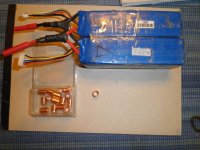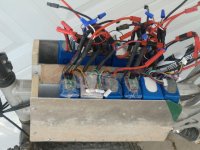mike662
10 W
I know this is probably discussed to death somewhere but it's almost impossible to find a thread on wires and connectors that gives me the info I need by searching those keywords as they show up in almost every thread.
So I was hoping you guys would be able to help me out on choosing what kind of wire and connectors to buy. I will be running a 20s lipo setup using the 4s1p5ah20c Turnigy hardcase batteries: http://www.hobbyking.com/hobbyking/store/__15521__Turnigy_5000mAh_4S1P_14_8v_20C_hardcase_pack.html My controller supposedly pulls around 30amps peak, although it is rated for 40. I am looking at buying cheap wire and small connectors that will be lightweight, but if I need to buy more expensive stuff for better performance I am willing to do that. I know anderson powerpoles and 10awg wire seem to be popular, but do I really need those? Can I just use the 4mm bullet-type connectors that are already on the batteries instead, or just directly solder the wires to each other instead of using connectors? I plan on bulk charging so I don't need to take apart the batteries unless one of them needs replacing.
I was looking at buying the 10awg turnigy wire from hobbyking and 30amp andersons from ebay. Will the 30 amp andersons fit the 10awg? And does this seem like something I should buy or can I get away with a lower quality wire?
Thanks so much in advance!
So I was hoping you guys would be able to help me out on choosing what kind of wire and connectors to buy. I will be running a 20s lipo setup using the 4s1p5ah20c Turnigy hardcase batteries: http://www.hobbyking.com/hobbyking/store/__15521__Turnigy_5000mAh_4S1P_14_8v_20C_hardcase_pack.html My controller supposedly pulls around 30amps peak, although it is rated for 40. I am looking at buying cheap wire and small connectors that will be lightweight, but if I need to buy more expensive stuff for better performance I am willing to do that. I know anderson powerpoles and 10awg wire seem to be popular, but do I really need those? Can I just use the 4mm bullet-type connectors that are already on the batteries instead, or just directly solder the wires to each other instead of using connectors? I plan on bulk charging so I don't need to take apart the batteries unless one of them needs replacing.
I was looking at buying the 10awg turnigy wire from hobbyking and 30amp andersons from ebay. Will the 30 amp andersons fit the 10awg? And does this seem like something I should buy or can I get away with a lower quality wire?
Thanks so much in advance!



